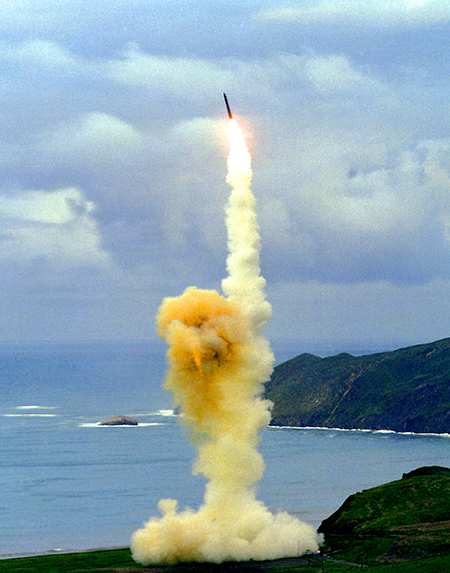GAO: ‘Feasible’ to Operate Minuteman III Through 2050
October 2025
By Xiaodon Liang
The U.S. Air Force’s program office for the Minuteman III intercontinental ballistic missile (ICBM) has concluded that the strategic delivery system can remain in service through 2050, according to a Sept. 10 report by the Government Accountability Office (GAO).

That finding calls into question previous statements by Air Force officials that the service life of the missile could not be further extended. In 2021, the head of Strategic Command, Adm. Charles Richard, said there was “no more margin” to keep the Minuteman III in service.
The new GAO study, which is an unclassified version of an April 2025 report to Congress, says Air Force officials informed GAO that they now “are confident that Minuteman III can be used beyond 2030, even out to 2050.”
But those officials also acknowledged certain “unknowns such as ground electrical subsystems and electronics—for example, diodes, resistors, and capacitors—which could degrade to unacceptable levels.”
The report concluded that the Air Force has not “developed a risk management plan [for the transition from Minuteman III to Sentinel] or other risk management tools consistent with leading project management practices.”
The Sentinel ICBM was scheduled to begin deployment in 2029 and completely replace all 400 existing Minuteman III missiles by 2036. But a large increase in the projected costs of the Sentinel program forced the Air Force to reassess its plans, potentially adding several years of delay. (See ACT, September 2024.)
The GAO said that the Pentagon’s internal study of the large cost projection increase—mandated by cost control provisions of the Nunn-McCurdy Act—attributed the unanticipated problems to an unrealistic delivery schedule, ineffective systems engineering, and an incomplete basic system design, as well as an “atrophied” ICBM industrial base.
“Continuing to sink billions into a program that is behind schedule, over budget, and unproven when the existing program could last 25 more years is a waste of taxpayer dollars,” said Rep. John Garamendi (D-Calif.), a critic of the Sentinel program in a statement to Arms Control Today. In March 2024, Garamendi and Sen. Elizabeth Warren (D-Mass.) asked the Air Force to study the possibility of life-extending Minuteman III to 2030, 2040, or 2050.
A senior Air Force official claims that a new plan, finalized this summer to dig fresh silos for the Sentinel missile rather than reuse Minuteman III missile silos would speed up deployment and bring the Sentinel back toward its original deployment schedule.
Speaking at the Mitchell Institute Aug. 27, Lt. Gen. Andrew Gebara, the Air Force’s deputy chief of staff for strategic deterrence and nuclear integration, argued that, because building new silos would not require rotating Minuteman III missiles off-duty, more could be built at once and construction would therefore be more efficient.
The Air Force has argued that a full life-extension program for the Minuteman III would not be cost effective. Those arguments, however, hinged on the assumptions that an ICBM force would have to remain in service through 2075 and that a life-extension program would have to make significant replacements of major components of the missile system.
Last July, Gebara said the Pentagon had studied a service life-extension program for the Minuteman III as part of its mandatory review of the Sentinel following the Nunn-McCurdy breach.
“A long-term [service life-extension program] still does not make sense for Minuteman,” but “what is going to happen is Minuteman sustainment to keep it viable until Sentinel is delivered,” he said.
Air Force officials responsible for Minuteman III sustainment met in February to assess “end of life 2050” challenges, Bloomberg reported in March. The GAO now says the Minuteman III program will request funding for sustainment of launch facilities in forthcoming budget requests.
The report also revealed that Air Force Global Strike Command has already shifted the majority of non-deployed launch facilities to F.E. Warren Air Force Base in Wyoming, whereas previously they were spread across the three U.S. ICBM bases. To comply with the numerical caps of the New Strategic Arms Reduction Treaty, the United States keeps 50 non-deployed ICBM silos in a warm reserve status.
The Air Force confirmed that one Minuteman III silo at F.E. Warren Air Force Base had been taken offline recently as part of the transition to Sentinel, Breaking Defense reported Sept. 3.
According to the GAO report, the base’s 90th Missile Wing transferred control of a non-deployed launch facility to Global Strike Command’s Site Activation Task Force in April 2025 so that the task force could “validate work concepts” to provide information for the transition to Sentinel.
